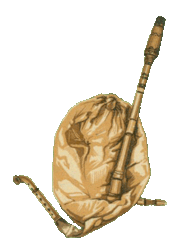.
Thrace is a historical region of Greece, Bulgaria and Turkey. The written musical history of the country extends back to ancient Greece, when Orpheus became a legendary musician. The region, at the time, was considered the musical center for the whole of Greece. Though the Thracian people were assimilated by surrounding groups, such as the Bulgarians, elements of Thracian folk music continue.
Traditional Thracian dances are usually swift in tempo, and are mostly circle dances in which the men dance at the front of the line.
Traditional Thracian dances are usually swift in tempo and are mostly circle dances in which the men dance at the front of the line.

The gaida, a kind of bagpipe, is the most characteristic instrument, but clarinets and toumbelekis are also used.
Types of dances
- Hassapia: an ancient dance that simulates a stealth approach on any enemy camp, from beginning to victory
- Kallinitikos: performed by three people (either two men and one woman or two women and one man), named after the kalines, or friends of the bride during her wedding, who escort her to the church performing this dance
- Kouseftos: derived from kousevo (to run in Thracian language), performed, not in a circle, but in the form of a labyrinth
- Mandilatos (Mandra): a couples dance performed at weddings
- Stis tris: a slow but swift dance
- Syngathistos: performed as the bride and groom are escorted to and from the church during weddings
- Xesyrtos: a circle dance with men performed at the front of the line
- Zonaradikos: a circle dance in which the participants hold each other's belts. This is the primary dance of Thrace and primarily danced by men where many tricks are performed.
- Paidushko (Baiduska, Pajdusko, Pajduska, Payduska): a very aggressive dance, usually performed by men. It is performed using heavy movement.
- Halay: Halay is a famous dance in the Middle East. It is a symbol for the tempestuous way of life in its place of origin, Anatolia. It is a national dance in Armenia and Turkey. The traditional form of the Halay dance is played on the Zurna, supported by a Davul. The dancers form a circle or line while holding each other with the little finger. From Anatolia the Halay has spread to many other regions such as Armenia and the Balkans.
The part of Thrace that is in modern Greece includes prominent elements of Turkish music.
| Ancient Greece
Science, Technology , Medicine , Warfare, , Biographies , Life , Cities/Places/Maps , Arts , Literature , Philosophy ,Olympics, Mythology , History , Images Medieval Greece / Byzantine Empire Science, Technology, Arts, , Warfare , Literature, Biographies, Icons, History Modern Greece Cities, Islands, Regions, Fauna/Flora ,Biographies , History , Warfare, Science/Technology, Literature, Music , Arts , Film/Actors , Sport , Fashion --- |
Retrieved from "http://en.wikipedia.org/"
All text is available under the terms of the GNU Free Documentation License

